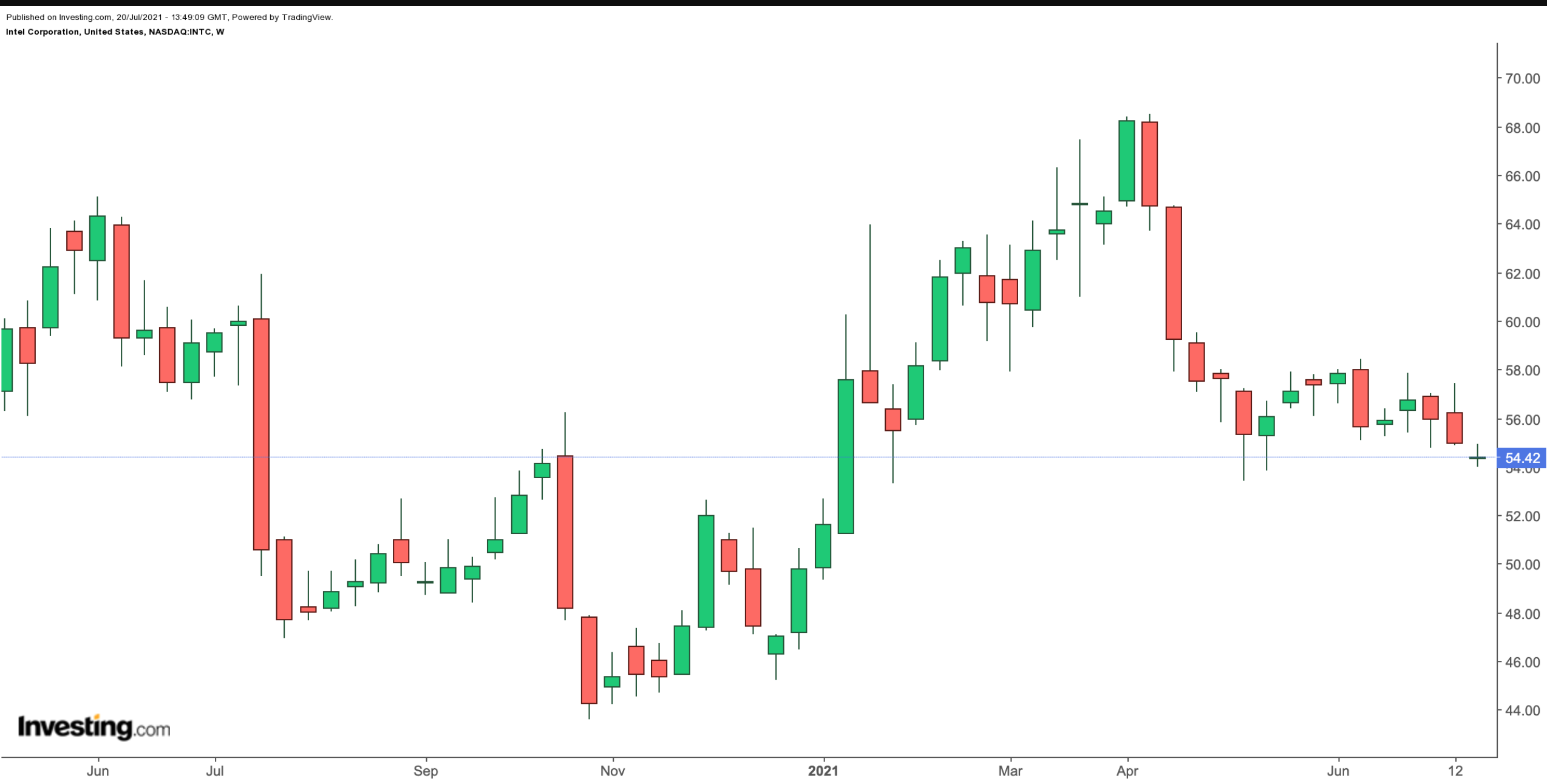Semiconductor industry heavyweight Intel (NASDAQ:INTC) reports earnings on Thursday, July 22 after the market close. So far, in 2021, INTC stock is up more than 10%. The current price supports a dividend yield of 2.5%.

By comparison, the Philadelphia Semiconductor Index is up about 13%. This is how several other chip heavyweights have fared year-to-date:
- Advanced Micro Devices (NASDAQ:AMD): down 5.8% YTD (covered here);
- Micron Technology (NASDAQ:MU): up 0.6% YTD (covered here);
- NVIDIA (NASDAQ:NVDA): up 40.2% YTD (covered here); and
- Taiwan Semiconductor Manufacturing (NYSE:TSM): up 6.7% YTD.
In a nutshell, returns for chip names have been mixed,which means the segment has been a stock picker's market. Understandably, Intel bulls are hoping that the upward move in the share price of the Santa Clara, California-based chip giant, seen so far this year, will continue, especially following the release of its quarterly results.
So, today, we look at INTC stock to see how investors could consider selling cash-secured put options. Such a trade could especially appeal to those who want to receive premiums (from put selling) or to potentially own Intel shares for less than their current market price of $54.51, at the time of writing.
In terms of 12-month price forecasts, the median target for the chip heavyweight is $63.80, implying a return of about 17%.
We previously discussed the detailed mechanics of cash-secured put selling using ExxonMobil (NYSE:XOM) stock. Readers who are new to put selling may want to consider reviewing that article.
Selling Cash-Secured Puts On INTC Stock
Investors who write cash-secured puts are typically bullish on a stock during the timeframe that extends to the option expiry date. They generally want one of two things. Either to:
- Generate income (through the premium received by selling the put); or
- Own a particular stock, but find the current market price per share (i.e., $54.51 for INTC now) higher than what they'd like to pay.
A put option contract on Intel stock is the option to sell 100 shares. Cash-secured means the investor has enough money in the brokerage account to purchase the security if the stock price falls and the option is assigned.
This cash reserve must remain in the account until the option position is closed, expires or the option is assigned, which means ownership has been transferred.
Let's assume an investor wants to buy INTC stock, but does not want to pay the full price of $54.51 per share. Instead, the investor would prefer buying the shares at a discount within the next six to 10 weeks.
One possibility is to wait for Intel stock to fall, which it might or might not do. The other possibility is to sell one contract of a cash-secured Intel put option.
As a result, the put seller would take on the obligation to potentially buy 100 shares of INTC at a certain price (the strike price) by the expiry date, and get paid a certain amount of premium now for taking on that obligation.
So the trader would typically write an at-the-money (ATM) or an out-of-the-money (OTM) INTC put option and simultaneously set aside enough cash to buy 100 shares of Intel stock.
Let's assume the trader is putting on this trade until the option expiry date of Sept.17. As the stock is currently $54.51, an OTM put option would have a strike of 52.5. So the seller would have to buy 100 shares of Intel at $52.50 if the option buyer were to exercise the option to assign it to the seller.
The INTC Sept. 17, 2021, 52.5-strike put option is currently offered at a price (or premium) of $2.10.
An option buyer would have to pay $2.10 X 100, or $210 in premium to the option seller. This premium amount belongs to the option seller no matter what happens in the future, i.e., until or on the day of expiry. This put option will stop trading on Friday, Sept. 17.
Risk/Reward Profile For Unmonitored Cash-Secured Put Selling
Assuming a trader would enter this cash-secured put option trade at $54.51, at expiration on Sept. 17, the maximum return for the seller would be $210, excluding trading commissions and costs.
The seller's maximum gain is this premium amount if INTC stock closes above the strike price of $52.50. Should that happen, the option expires worthless.
If the put option is in the money (meaning the market price of Intel stock is lower than the strike price of $52.50) any time before or at expiration on Sept.17, this put option can be assigned. The seller would then be obligated to buy 100 shares of INTC stock at the put option's strike price of $52.50 (i.e., at a total of $5,250).
The break-even point for our example is the strike price ($52.50) less the option premium received ($2.10), i.e., $50.40. This is the price at which the seller would start to incur a loss.
On a final note, the calculation of the maximum loss assumes the put seller was assigned the option and purchased 100 shares of Intel at the strike price of $52.50. Then, in theory, the stock could fall to zero.
If the put seller gets assigned the option, the maximum risk is similar to that of stock ownership but partially offset by the premium (of $210) received.
Bottom Line
Cash-secured put selling is a moderately more conservative strategy than buying shares of a company outright at the current market price. This strategy can be a way to capitalize on the choppiness in Intel stock during the earnings release with a measure of prudence.
Those investors who end up owning INTC shares as a result of selling puts could further consider setting up covered calls to increase the potential returns on their shares. In other words, selling cash-secured puts could be regarded as the first step in stock ownership. Once the investor owns 100 shares of Intel, s/he would also be able to sell covered calls and potentially enhance returns further.
